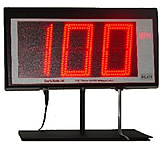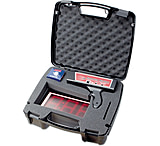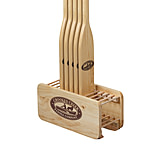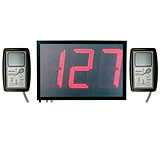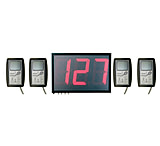RADAR is an acronym which stands for Radio Detection And Ranging. A RADAR is a remote sensor that emits electromagnetic waves in order to measure reflections for detection purposes. RADAR can be used to determine:![]()
- Presence
- Location
- Motion
How Does a Radar Gun Work?
The Doppler Principle - The Doppler Effect is a frequency shift that results from relative motion between a frequency source and a listener. If the source and the listener are not moving with respect to each other, then no Doppler shift occurs. If the source and the listener are moving towards each other, the listener will perceive a higher frequency. The faster the speed of the approach, the higher the return frequency will be. If the source and the listener are moving away from each other, the listener will perceive a lower frequency. The faster the speed of separation, the lower the return frequency will be. The Doppler shift is directly proportional to the speed between the source and the listener, the frequency of the source, and the speed the wave travels.

A Speed RADAR Gun is a small microwave emitter that transmits a beam of electromagnetic waves and uses the reflected signal to calculate the speed of the target. Speed Radar Guns calculate the Doppler Shift from the transmitted frequency to the return frequency when reflected from a target to determine the speed of the target object. A typical Speed RADAR unit emits a beam 12° to 25° wide, with Police RADAR units staying closer to 12°. OpticsPlanet sells two main categories of RADAR guns: Sports RADAR Guns and Police RADAR Guns.
Calibration of Speed
All RADAR guns are calibrated from the factory. There is no way for the user to calibrate a RADAR gun; however, many higher-end models come with a tuning fork to check the calibration. A tuning fork is used to make sure that the RADAR gun is properly calculating speeds. Tuning forks are stamped with a specific speed. If the RADAR reads a large difference in speed to the number on the tuning fork, it's time to have the RADAR calibrated by the factory.
Radar Guns for Sports
A Sports RADAR Gun has the widest variety of uses and is the most difficult category of RADAR guns for which to make recommendations. Many sports RADAR guns are specific to a certain sport and do not work well for other applications. Many Sports RADAR units have different modes for different uses. Many different models have the same mode names, such as Continuous, but the modes often have completely different functions.
- Peak Speed - Displays the fastest speed measured
- Continuous - Displays the current speed of the target OR
- Continuous - Continually operates in Peak Speed (No trigger use required)
Baseball RADAR Gun
The fastest speed of a pitch is always within 1 foot of the release from the pitchers hand. This is the spot at which you want to aim the RADAR. After this point, the ball starts decelerating. A Baseball RADAR gun is programmed to take the first speed detected and lock it onto the display. This is the peak speed mode of a baseball RADAR gun. This first speed is generally the only speed that is of concern to a pitcher. Some models have now come out with an option to measure both the release speed and the plate speed. When a RADAR gun for baseball is set to continuous mode (certain models) it still measures the first speed detected. The RADAR gun will display this speed for approximately three seconds and then resets itself for the next pitch. This is primarily designed for use on a tripod with an external display.
Motorcross RADAR Gun
With motorsports, the RADAR user is concerned with the current speed of the vehicle. If the vehicle accelerates or decelerates, the user wants to know the new speed of the vehicle without having to repress the trigger. As the target changes speed, the speed on the display is constantly updated with the new speed. This is the motorsports version of continuous mode. If a RADAR user is at the drag strip, they are generally concerned with the fastest speed that the target reaches. Peak speed mode in a motorsports RADAR gun will display continuous speed until the target reaches it maximum speed or starts decelerating. The highest speed recorded will remain on the display.
Tennis RADAR Gun
A Tennis RADAR gun operates in the same manner as a baseball RADAR gun, and usually has a faster top end speed and a shorter range.
Police Radar Guns
Police RADAR guns are used to measure the speed of vehicular traffic. Police RADAR guns can be either handheld or permanently mounted to the patrol vehicle. The biggest difference between a Police RADAR gun and a Sports RADAR gun is that a Police RADAR gun is certified by the International Association of Chiefs of Police (IACP) for use as law enforcement RADAR. Without this certification the data collected on a RADAR gun cannot be used in court to impose a traffic violation in the US. Police RADAR guns are made in both stationary models and moving models.
- Stationary RADAR can only be used while the patrol vehicle is parked.
- Moving RADAR can be used while the patrol vehicle is in motion. Moving RADAR measures both the speed of the target vehicle in relation to the patrol car and the ground speed of the patrol car and calculates the difference to determine the actual speed of the target vehicle.
- Directional RADAR guns can measure the speed of vehicles both approaching and moving away from the patrol vehicle. Many directional RADAR guns can also block out one direction, so they only read the speed of vehicles moving in the other direction.
Police RADAR guns are usually purchased by an existing department to replace or add units to their fleet, and the customer usually already knows what they want. Police RADAR guns are chosen according to specific features and abilities of the unit, as previously determined by the department.
What Can Affect a RADAR Gun's Speed Reading?
- Weather: Rain, Snow, fog, humidity, and particulate matter in the atmosphere can all affect the range of a RADAR gun. They all provide different levels of resistance to the air and will greatly shorten the range of a RADAR gun.
- Range: All RADAR guns have a limited range. The range is limited by the power of the transmitter and the size of the target. The larger the target and the higher the power of the RADAR, the greater is the range of the RADAR. If the target is out of range of the RADAR, the user will get no speed reading.
- Visibility: Speed RADAR cannot "see" through walls or around corners. Many lower power units also have difficulty getting a speed reading through an obstruction such as a metal backstop.
- The Cosine Effect: The measured speed of a target is directly related to the cosine of the angle (alpha) between the RADAR and the target direction of travel.

The greater the distance between the RADAR and the target path, the slower the recorded speed will be.

The best place for a RADAR gun to be is as close to the direct path of the target as possible.
Shop online for RADAR guns today at OpticsPlanet to save big on baseball RADAR guns, speed RADAR guns for police, and RADAR Gun Accessories like tripods, LED speed displays, mounts, and more!










